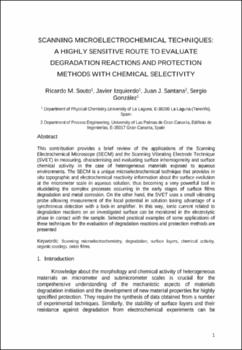Scanning microelectrochemical techniques a highly sensitive route to evaluate degradation reactions and protection methods with chemical selectivity
Fecha
2013Resumen
This contribution provides a brief review of the applications of the Scanning Electrochemical Microscope (SECM) and the Scanning Vibrating Electrode Technique (SVET) in measuring, characterising and evaluating surface inhomogeneity and surface chemical activity in the case of heterogeneous materials exposed to aqueous environments. The SECM is a unique microelectrochemical technique that provides in situ topographic and electrochemical reactivity information about the surface evolution at the micrometer scale in aqueous solution, thus becoming a very powerful tool in elucidating the complex processes occurring in the early stages of surface films degradation and metal corrosion. On the other hand, the SVET uses a small vibrating probe allowing measurement of the local potential in solution taking advantage of a synchronous detection with a lock-in amplifier. In this way, ionic current related to degradation reactions on an investigated surface can be monitored in the electrolytic phase in contact with the sample. Selected practical examples of some applications of these techniques for the evaluation of degradation reactions and protection methods are presented






